Saved Bookmarks
Explore topic-wise InterviewSolutions in .
This section includes InterviewSolutions, each offering curated multiple-choice questions to sharpen your knowledge and support exam preparation. Choose a topic below to get started.
| 3701. |
Question : Describe various strategies by which the food is taken in and used by the organism |
| Answer» Solution :VARIOUS strategies are followed by organisms to obtain and digest the food because the food and the way to obtain it DIFFER. The digestive system is different in various organisms. In single cell organism, the food may be taken in by the entire surface. But as the COMPLEXITY of the organism increases, different parts become specialised to perform different functions. For example, AMOEBA takes its food using temporary finger-like extensions of the cell surface and diffuses it into the CYTOPLASM where as human beings eat ripe and cooked food and gets it digested in his stomach. | |
| 3702. |
Question : Describe various strategies of heterotrophic nutrition. |
|
Answer» Solution :Heterotrophic nutrition is a mode of nutrition in which organisms OBTAIN ready made organic food from outside sources. The organisms depend upon out side sources. The organisms that depend upon out side sources for obtaining organic nutrients are called heterotrophs. It is a characteristic feature of all animals and non-green plants, that are unable to utilize carbon and synthesis organic compounds NECESSARY for life, but depends upon organic sources of carbon. They are thus dependent upon autotrophic organisms (Plants) and are called as heterotrophs. It is of the following types: (i) Saprophytic nutrition. In this type of nutrition, an organism LIVES upon dead organic sources such as dead plants and dead animals. These usually secrete dissolving and DIGESTING enzymes and absorb the liquefied molecules so formed e.g. yeast, bread moulds and dung moulds etc. (ii) Parasitic nutrition. In this type of nutrition, an organism lives totally at the expense of others and derives its food material and shelter from the other. These organisms which derive food material are called parasites and the organisms from which food is derived is called as host. This type of nutrition is termed as parasitic or holozoic nutrition. It is also known as parasite-host relationship e.g. Cuscuta, Ascaris etc. (iii) Holozoic nutrition. It is a mode of heterotrophic nutrition which invovles intake of solid pieces of food. Since solid food is taken in, Holozoic nutrition is also called ingestive nutrition. Holozoic nutrition (GK. "Holo".Whole, "Zoon"-Animal) is found in animals and protists. The food may consist of another animals, plant or its parts. Depending upon the source of food, holozoic organisms are of three types: (a) Herbivores : These organism obtain their food from plants e.g. cow, rat, deer and goat etc. (b) Carnivores : These organism take the flesh of other organisms as their food e.g. tiger, CHEETAH, snake, eagle, etc. (c) Omnivores: These can feed on plants and flesh of other organisms e.g. human, cockroach, crow, etc. |
|
| 3703. |
Question : Describe two examples of different oxidations of ethanol. Name the products obtained in each case |
|
Answer» SOLUTION :i) When ETHANOL is heated with COPPER at 573k, Ethanol if is formed. `CH_(3)CH_(2)OH to CH_(3)-overset(O)overset(||)C-H+H_(2)` ii) When Ethanol is oxidised with ALKALINE potassium permanganate solution, ethanoic acid is formed. `CH_(3)CH_(2)OH+2(O) to CH_(3)-overset(O)overset(||)C-OH+H_(2)O` |
|
| 3704. |
Question : Describe the working of artificial kidney |
Answer» Solution :Artificial kidneys contain a number of tubes with a semi-permeablelining suspended in a tank filled with dialysingfluid. This fluid has the same osmotic pressure as pure BLOOD, except that it is devoid of nitrogenous WASTES. The patient.s blood is passed through these . Duringthis passage, the wasteproducts from the blood PASS into dialysingfluid by diffusion due to CONCENTRATION gradient. Thepurified blood is then pumped back into thepatient . This is similar to the function of the kidney, but it is differentsince there is no reabsorptioninvolved.
|
|
| 3705. |
Question : Describe the various steps involved in the sexual reproduction in animals . Draw labelled diagrams to show the fertlilisation of an ovum (or egg) by a sperm to from a zygote |
|
Answer» |
|
| 3706. |
Question : Describe the various methods of birth control. |
|
Answer» Solution :The various methods of birth control are : 1. PHYSICAL barriers-Use of contraceptives.- It means prevention of conception : Following contraceptives are popular : (a) Diaphragm. The vaginal diaphragm is a rubber cup stretches over a collapsible metal spring COIL. It is designed to fit over the cervix, i.e. the mouth of uterus which prevents fertility or conception. (b) Condom. The condom is a sheath of rubber which fits on the erect penis. It is put on the penis before it is introduced in the vagina during intercourse. (c) Jellies, creams and foams. A number of different spermicidal jellies, creams and foams are available for use as contraceptive agents. These jellies, creams and foams are inserted into vagina five to FIFTEEN minutes before ejaculation to take place. (d) Introduction of copper T or loop in female uterus prevents the entry of sperms in uterus. 2. Chemical Methods. ORAL Contraceptives. These are popularly known as "pills" and are combinations of synthetic sex hormones which suppress the production of ovum. These pills alter the ovulation cycle. .Mala. and .Saheli. are the two common pills. 3. Surgical methods. Sterilization. It is surgical technique by which the passage of sperms or ovum is discontinued. Both men and WOMEN can be sterilized without losing their ability to function sexually. (a) Vasectomy. In men the sterilization procedure is called vasectomy. (b) Tubectomy. In woman part of fallopian tube is cut and tied off. 4. Medical termination of pregnancy (MTP). It is the cessation of pregnancy by surgery, suction or by other means. 5. Other measures. (a) Abstinence. Abstaining from intercourse. (b) Coitus interruptus. It involves the withdrawal of penis from the vagina before ejaculation occurs. (c) Zero .0. method. It is natural effective and practical method where the woman has to find out herself the fertile and infertile period, by keeping a close watch on uterine discharge. The safest period to avoid pregnancy is from the beginning of mucus discharge to next four days, after the discharge has stopped. |
|
| 3707. |
Question : Describe the structure ofnephron with the hepl of diagram. |
Answer» Solution :Structure of the Nephron : 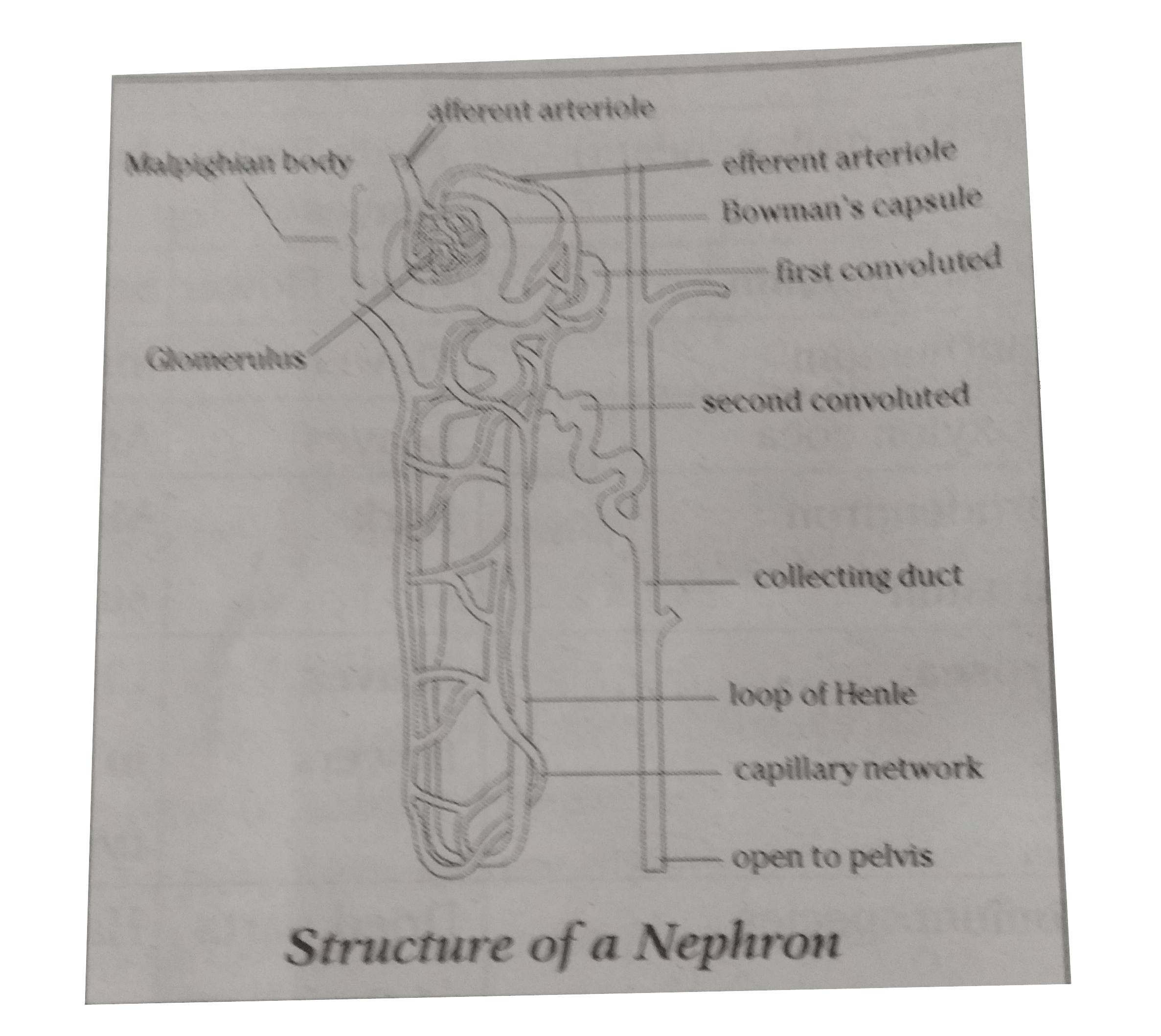 1. Each Nephron has basically TWO parts : 1. Malpighian body 2. Renal tubule MalpighianBody : 2. It consists of Bowman's capsule and bunch of fine BLOOD capillaries CALLED glomerulus. 3. Glomerulus develops from afferent arteriole. It gives rise to an efferent arteriole. Renal Tubule : 4. It three parts 1. Proximal Convoluted Tubule (PCT) 2. Loop of HENLE 3. 'U' shaped second or Distal Convoluted Tubule (DCT) |
|
| 3708. |
Question : Describe the structure of human urinary system with diagram . |
Answer» SOLUTION :Human Excretory System 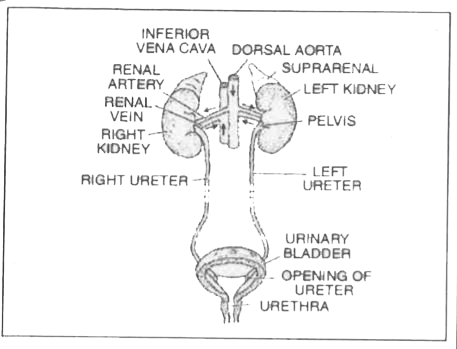 The urinary system consists of the following: 1. Kidneys2. Ureters 3. Urinary bladder 4. Urethra. 1. KIDNEYS. The kidneys are a pair of bean-shaped DELICATE organs. They are situated one on each side of the mid-dorsal line of the abdominal cavity, just below the level of the stomach. 2. Ureters. They are two tubes about 30 cm long, emerging from each kidney with the pelvis of which they are continuous. The ureters run downwards and inwards and open into the urinary bladder. 3. Urinary bladder. It serves as a reservoir for the urine. It is a hollow muscular organ lined by STRATIFIED epithelium. Its average capacity for storage is about 500 mm. It is situated in the cavity of the pelvis just behind the pubic symphysis. 4. Urethra. The urethra in two sexes differ. The male urethra is about 20 cm in length. The female urethra is a short duct of about 4 cm long and its extends from the urinary bladder to the external urethra orifice which is in the vestibule just above and anterior to the vaginal orifice. |
|
| 3709. |
Question : Describe the structure of male reproductive system in human beings. |
|
Answer» Solution :(1) The male reproductive system of human bering consists of a pair of testis, accessory GLANDS and a system of ducts . (2) Testis are male reproductive organs and produces spermotozoa or sperms and also secretes male sex horomone Testosterone. (3) Inside each testis several lobules are present. Each lobule has several tubules called seminiferons tubules. (4) Germinal epithelial cells in the seminiferous tubules undergo meiotic division to produce spores. (5) The accessory glands include one prostrate gland and two cowper gland . Secretion of these gland produce semen.  (6) The DUCT system consists of vasefferentia. They collect spermatozoa from seminiferous tubules. (7) Vasefferentia CONTINUE as epididymis where sperms are stored TEMPORARILY. (8) From epididymis sperms moved into tubule called vasdeferens and then into urethra. |
|
| 3710. |
Question : Describe the structure of human heart. |
|
Answer» Solution :Heart. 1. It is a highly efficient, pumping organ of body. Human heart consists of 4 chambers: upper SMALLER RIGHT and left atria (auricles) with thinner wall and lower larger right and left ventricles with thicker walls. 2. Atria open into the respective ventricles by atrioventricular apertures guarded by atrioventricular valves.3. The two atria are separated from each other by interatrial septum, and the two ventricles are separated from each other by interventricular septum.4. The sinoatrial node (SAN) or the pacemaker is located in the upper wall of right atrium. Valves of the heart Valves are muscular flaps which prevent the blood to FLOW back through it. Two types of heart valves are distinguished :1. The Atrioventicular valves. These valves separate the atria from the ventricles. The right side of the heart possesses the tricuspid valve or right atrioventricular valve and the left side of the heart possesses the bicuspid or mitral valve. 2. Semilunar valves. These are located in the arteries leaving the heart. The PULMONARY semilunar valves lies in the OPENING where the pulmonary trunk leaves the right ventricle and aortic semilunar valve lies at the opening between the left ventricle and aorta. |
|
| 3711. |
Question : Describe the structure of human kidney. |
|
Answer» Solution :Kidneys are bean-shaped and located at the back of abdomen, ONE on either SIDE of backbone. Its inner concave surface has a depression called hilum through which RENAL artery enters and renal vein leaves the kidney. Kidney has two regions: outer CORTEX and inner medulla. Each kidney has a large num ber of FILTERING units called nephrons. 
|
|
| 3712. |
Question : Describe the structureof flower with a neatly labelled diagram. |
|
Answer» Solution :(1) A typical flower CONSISTS of an outer whorl of green sepals (calyx) which protects the parts within . (2)Tha second whorl has PETALS (corolla ) which are usually brightly colored . They sometimes have fragrance also . (3)Petals are soft and are useful to fasilitate cross pollination . (4)The third whorl of the flower consists of stamens (androecium ) which are the the male REPRODUCTIVE organs . (5)Each stamen is made up of a filament and an anther . (6)Each anther usually has two anther lobes . the anther producse pollen GRAINS (microspores.) (7) The inner most fourth whorl is gynoecium or pistil . it consists of ovary . style and stigma . (8)Ovary occupies central protion on the thalamus . a awollen ovary is present on the thalamus. (9) Inside the ovaery future seeds . knwon as ovles are present. (10) Ovary has a pipe LIKE extension called style . The tip of the style ends in stigma . the stigma receive the pollen grains. 
|
|
| 3713. |
Question : Describe the structure of a pollen grain. |
| Answer» Solution :Stamens produce pollen grains that are yellowish in COLOUR. Pollen GRAIN is unicellular and haploid. It has two layers, the THICKER outer one is called exine, which is THIN at places called germ pores and inner thin layer is called intine. | |
| 3714. |
Question : Describethestructureand workingof thehumanheart . |
|
Answer» Solution :The human heart is four chambered. The two upper THIN walled chambers, Auricle or ATRIA and the lower thick walled chambers ventricles. The chambers are separated by septum. Thetwo AURICLES are separated by inter atrial septum and the two ventricles are separated by inter ventricular septum. The right atrium receives deoxygenated blood from different parts of the body through superior vena cava, inferior vena cava and coronary sinus. Pulmonary veins bring oxygenated blood from the lungs to the left atrium. Both the right and the left auricles PUMP blood into the right and left ventricles respectively. From the right ventricle, the pulmonary arteries supply deoxygenated blood to the lungs. From the left ventricle, the Aorta carries the Oxygenated blood to the VARIOUS organs of the body. The coronary arteries supply blood to the heart. This process is repeated again and again. |
|
| 3715. |
Question : Describe the structure of a flower. |
|
Answer» Solution :1. Pedicel. It is stalk of the flower which raises it in the air to expose the flower to the pollinating agencies. Pedicel may bear two small leaf- LIKE appendages called bracteoles. 2. Thalamus. The swollen or broad base or flat apex of pedicel that BEARS the floral leaves is called thalamus or torus. 3. Calyx or Sepals. The sepals are the outermost whorl of flower. They are collectively known as calyx. Calyx is green, appears first on the thalamus and is protective in function. 4. Corolla or Petals. It is second whorl of flower. They are brightly coloured leaf-like flattened structures. Petals may also be scented and have nectar glands at the base to attract pollinating agents i.e. insects. 5. Stamens or Androecium. Stamens are the male reproductive parts of the flower. Each STAMEN consists of a SLENDER stalk filament and knob-like terminal anther. Each anther has two anther lobes. Each anther lobe has two pollen chambers containing pollen grains. 6. Carpels or Gynaecium. The carpels represent the female parts of a flower. They are present on the central region of thalamus. They may be free or united. The free occurring unit of gynaecium is called pistil. Each pistil consists of three parts ovary, style and STIGMA. |
|
| 3716. |
Question : Describe thestructureandfunctioningof nephrons. |
|
Answer» Solution :Nephron is a structural and functional unit of KIDNEY. A nephron has two parts - malphigian bodyand renal TUBULE . Malphigian BODY - or renal corpuscle comprises of Bowman.s capsule (a cup SHAPED structure) and glomerulus (abunch of fine blood vessels in Bowman.s capsule). Glomerulus develops from an afferent arteriole whichgivesrise to efferentarteriole. Renal tubule - Comprises of convoluted tubules whichopensinto a collecting tubule. Collecting tubules of differentnephronsjoins to forma collecting duct. Nephrons filter the blood in order in remove nitrogenousmetabolicwaste. Theyalso absorb some useful substances such as GLUCOSE, amino acids, minerals and major amount of water from the filtrate. 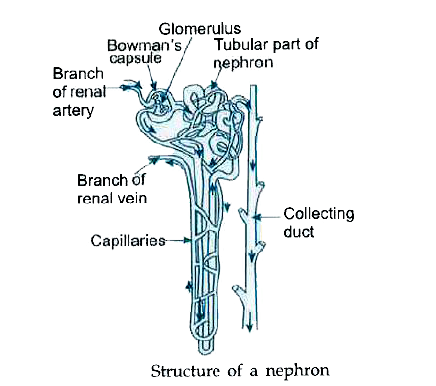
|
|
| 3717. |
Question : Describe the structure and functioning of nephron. |
|
Answer» Solution :Structure of a Nephron A nephron is made up of (i) a globular double walled Bowman.s capsule around a clump of capillaries or glomerulus, and (ii) a tubule surrounded by blood capillaries. The tubule consists of (a) a proximal convoluted portion, (b) the loop of Henle, with descending and ascending limbs, and (e) a distal convoluted part. The nephron empties into a collecting duct. The two million nephrons of a human being, end to end would extend for nearly 80 km. All the collecting ducts discharge into a central cavity of the kidney (pelvis) that CONNECTS to the ureter. Functioning of Nephron Urine is formed by 3 processes : glomerular filtration, tubular reabsorption and tubular secretion in the nephrons of kidney. 1. Ultrafiltration (Glomerular filtration) Blood is filtered under pressure in the glomeruli present in the cup like structure of Bowman.s capsule. Glomerular (nephric) filtrate is formed. 2. Tubular reabsorption In the PCT, entire GLUCOSE, amino acids, vitamins and hormones, most of the inorganic ions are reabsorbed by active transport, most of water by osmosis, and some urea by back DIFFUSION from nephric filtrate. Loop of Henle mainly concentrates urine to conserve water. Here, some inorganic ions are actively taken up and some water leaves by osmosis. 3. Tubular secretion In the DCT, collecting tubule and collecting duct, many ions, water (depending upon availability) are secreted in to DCT and collecting duct. Urine formed passes into bladder from kidney through ureters. |
|
| 3718. |
Question : Describe the structure and functioning of nephrons. |
Answer» Solution :Nephrons are the basic filtering units of kidneys. Each kidney possesses large number of nephrons, APPROXIMATELY 1-1.5 million. The main COMPONENTS of the nephron are glomerulus, Bowman.s capsule and a long renal tubule.  Functioning of a nephron :• The blood enters the kidney through the renal artery, which branches into many capillaries associated with glomerulus. • The WATER and solute are transferred to the nephron at Bowman.s capsule. • In the proximal tabule, some tubule, some substances such as amino acids, glucose, and salts are selectively, reabrosbed and unwanted molecules are added in the urine. • The filtrate then moves down into the loop where more water is obsorbed. • Form here, the filterate moves upwards into the DISTAL tubule and finally to the collecting duct. Collecting duct collects urine from many nephrons. • The urine FORMED in each kidney enters a long tube called ureter. From ureter it gets transported to urinary bladder and then into the urethra. |
|
| 3719. |
Question : Describe the process of respiration in the following parts of a plant: (a) Root (b) Stem (c) Leaves |
| Answer» | |
| 3720. |
Question : Describe the process of respiration in fish. |
| Answer» | |
| 3721. |
Question : Describe the process of fission, budding and spore formation in living organism. |
|
Answer» Solution :Asexual reproduction occurs in following ways: (i) Fission: It is the process of asexual reproduction in unicellular ORGANISMS, such as AMOEBA and paramecium. Fission is again of two types : (a) Binary fission: During binary fission, the nuclear division takes place first, followed by the appearance of a constriction in the cellmembrane, which gradually increases inwards and divides the cytoplasm into two parts. Finally two daughter cells are formed. (b) Multiple fission: The type of fission in which not two but several individuals arise, from one individual is called multiple fission. During multiple fission, the nucleus divides several times into many daughter nuclei. The daughter nuclei arrange along the periphery of the parent cell and a bit of cytoplasm accumulates around each daughter nuclei. Finally, the daughter nuclei DEVELOPS an outer membrane and the multinucleated BODY divides into as many parts as the number of daughter nuclei and forms daughter individuals. 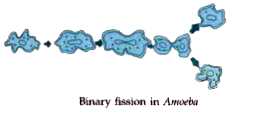 (ii) Budding : Budding is seen in both multicellular (Hydra) and unicellular organisms (yeast).  In Hydra, a bulge in the body appears as a result of repeated mitotic division in the cells. These lateral bulges are called buds. These buds slowly develop into a new Hydra and get separated from the parent. In yeast, a small protuberance appears on the upper part of an adult cell. This protuberance grows in size. From this newly budded cell, another bud appears at the tip. This process continues 3 - 4 times, resulting in a chain of yeast cells. (iii) Spore formation : Spore formation is the most common method of asexual reproduction seen in FUNGI and bacteria. During spore formation, a structure called sporangium develops from the fungal hyphae. The nucleus divides several times within the sporangium and each nucleus with a bit of cytoplasm, develops into a spore. The spores are liberated and they develop into new hyphae after reaching the ground. e.g., Rhizopus, Mucor and Penicillium. |
|
| 3722. |
Question : The role of double fertilization in angiosperms is to produce |
|
Answer» Solution :Double fertilization : (1) In flowering plant germinated POLLEN grain forms pollen tube . The end the pollen tube ruptures and TWO male gamets are releasaed un the embryosac (2) out of two male gamets one gamets fuses with female gamet which is called fertillizatoin another male fuses with the secondary nacleus and forms ENDOSPERM. (3) so in flowering plants fretilization occurs twice hence it is called double fertilizatoin. use of endosperm : (1) cotyledons DEVELOPS by utilizing endosperm (2) the cotyledons ytilizes the stored food in the endosperm (3) some of the plants utilizes the endosperm completely andchanges in tom seed . (4) becaues of the stored food the size of the cotyledons increases. |
|
| 3723. |
Question : Describe the process of digestion of food in man . |
|
Answer» Solution :Process of digestion starts in mouth where secretion of three pairs of salivary glands known as saliva mixed with food Saliva contains an enzyme ptyalin (Amylase) which digests starch and converts in into maltose. From mouth food reaches the stomachwhere gastric glands are present having threetypes of cells. Thesesecrete hydrochloric acid, protein digesting enzyme (Pepsin) and mucusrespectively. Small amountof gastric lipase is also present in the gastric juice secreted by theseglands. Pepsin digests proteinand converts it intopeptones. Hydrochloric acid kill bacteria presentin the food, prevents fermentation of semi-digested food and provides acidic medium which is essential for digestionof protein in stomachby the enzyme pepsin as it can act only in acidic medium. Gastric lipase partially breaks downlipids (fat) into glycerol and FATTY acids. From stomach semi-digested food reaches the firstpart of small intestinecalled duodenum. Itis a U shaped structureand receives the secretion of common duct. It bringssecretions of liver (Bile) and pancreas (Pancreatic juice) to small intestine. Bile emulsifies fat and converts fat MOLECULES into small globules and chages and medium of food from acidicto alkaline. Pancreatic juice contains following enzymes : (i) Trypsin which converts proteinsinto peptone and peptides. (ii) Amylase which convertsstarch into SIMPLE sugar. (iii)Lipase which converts fats into fatty acid and glycerol. walls of small intestinealsohave glands whose secretion in known as succus entericus. This intestinal juice completes the digestion of fat, proteinand CARBOHYDRATE. In small intestine the final end product of protein is amino acid, of starch is glucose and fat is finally CONVERTEDINTO fatty acidand glycerol. Finally , the digestedfood is absorbed by the walls of small intestine which containsabundantfinger-like projections called villi whichhave rich supply of blood. |
|
| 3724. |
Question : Describe the process of digestion of food in human beings. |
Answer» Solution :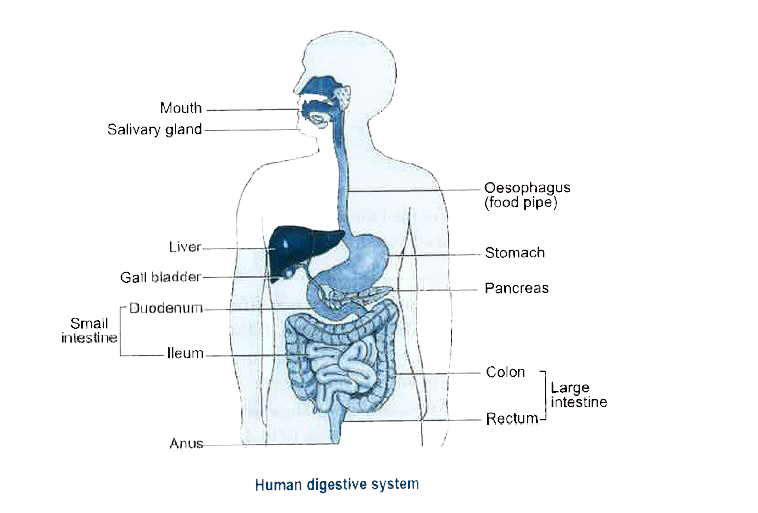 The various processes involved in the digestion of human beings are: (i) Ingestion: Through the help of mouth human beings ingest food. (ii) Digestion: The teeth helps in physical digestion of food. In mouth there are salivary glands, which secretes saliva, in which salivary amylase enzyme is present which digest the starch present in food into maltose sugar, i.e., the digestion of carbohydrate starts from mouth itself. Mouth opens into a small funnel-shaped area called pharynx which leads to a long tube called oesophagus, whose wall is highly muscular. When the slightly digested food enters into oesophagus the contraction and expansion movement of its wall, takes place, which is known as peristaltic movement. This movement helps the food to move towards the stomach. Usually, in oesophagus there is no digestion of food. From the oesophagus the food enters into the stomach. In the stomach there is secretion of gastric juices which is a mixture of hydrochloric acid, pepsin (protein digesting enzyme) and mucus. Now, the partially digested food enters from stomach into the small INTESTINE’s wider part which is known as duodenum and the remaining part of the small intestine is termed as ileum. The duodenum, receives secretions of two glands, i.e., liver and pancreas. Liver secretes bile pigments and pancreas secretes pancreatic juice which digestes the proteins, CARBOHYDRATES and emulsified fats. Here the digestive enzymes are amylase, maltose and INVERTASE for digesting the carbohydrates, trypsin for proteins and lipase for fats. Thus, food is completely digested in ileum part of small intestine. (ii) ABSORPTION: Now, the food enters from duodenum into ileum part of small intestine where MILLIONS of finger-like projections known as villi are present which absorb the food. (iv) Assimilation: The blood carries the digested and dissolved food to all parts of the body, where it is assimilated into the cells which is used for obtaining energy as well as for growth and repair of the body. (v) Egestion: The undigested food enters into the large intestine’s wider part, where water is absorbed from the undigested food and the food becomes solid. Now, this solid undigested food enters the last part of large intestine known as rectum through which it moves out from the body. |
|
| 3725. |
Question : Explain the process of fertilization in plants. |
|
Answer» Solution :(1) Fertilisation is the process of fusion of make male and female gametes. (2) For the fusion ofmale and female gametes pollen grains have to reach the surface of the stigma. This is CALLED pollination. (3) Pollen grain received by the stigma germinate and give rise to pollen tubes. Only one pollen tube finally reaches the embryosac. (4) This tube will have two male nuclei, which migrate to the tip of the pollen tube at the time of fertilization. (5) Usally the pollen tube enters the ovule through micropyle and discharge the two male gemtes into this embryosac.  (6) One male nucleus (gamete) approaches the egg and fuses with it to form a diploid (2n) zygote. this is FIRST fertilisation. ` n oversetuarr O + n underset +O rarr2n ("zygote")` (7) The other male nucleus (gamete) reaches the secondary nucleus (2n) and fuses with it to form endosperm nucleus which will be TRIPLOID. this is second fertilization in the embryosac. `n overset uarr O+2n underset +O RARR 3n (P.E.N)` (8) Thus double fertilisation occurs in embryosac which is unique in flowering plants. |
|
| 3726. |
Question : Describe the methods for population control. |
|
Answer» Solution :The sexual act always has the potential to lead to pregnancy. There are many WAYS that have been devised to avoid pregnancy and there- by achieving population control. Contraceptive methods fall in following categories : (1) Mechanical barrier : By the use of it SPERM does not reach the egg. Condoms or similar barriers WORN in the vagina can serve this purpose. Other contraceptive Intrauterine devices (IUD) such as loop or copper-T are placed in the uterus to prevent pregnancy. It may cause side effects due to irritation of the uterus. (2) Chemical methods : In this method, contraceptive pills have to be taken orally by FEMALE. The drugs in contraceptive pills change the hormonal balance of the female body in such a way that eggs are not released making fertilisation impossible. Since they change hormonal balances, they can cause side-effects too. (3) Surgical methods : If the vas deferens in the male is blocked, sperm transfer will be prevented. If the fallopian tube in the female is blocked, the egg will not be able to reach the uterus. In both cases fertilisation will not take place. Surgical methods can be used for such blocks. While surgical methods are safe in the long run, SURGERY itself can cause infections and other problems if not performed properly. 
|
|
| 3727. |
Question : Describe the mechanism of breathing in man. |
|
Answer» Solution :Breathing is a physical process INVOLVING inflow (inspiration) and outflow (expiration) of air between atmosphere and the ALVEOLI of the ling. During inspiration,the intercostalmusclescontract and pull the RIB cage upwards and outwards. At the sametime, the diaphragm contracts and flattens. These movements increase the volume and thereforelowersthe pressure in the thorax/chest cavity . As the pressure in the chest cavity FALLS belowthatof the atmosphere, airrushes in. During expiration (breathing out), relaxation of intercostal muscles and diaphragm takes place. The ribs move downwards and inwards. The volume of the lungs decreases, squeezingthe air inside them. Diaphragm comes back to its ogiginal C-shaped position. This increases the airpressureinsidethe lungs, forcing it out. |
|
| 3728. |
Question : Describe the life cycle of a flowering plant with a help of labelled diagrams. |
|
Answer» Solution :(1) Adult plant produces flower : When the plant matures and is ready to reproduce, it develops flowers. Flowers are special structures involved in sexual reproduction , which includes POLLINATION and fertilisation.  (2) Pollination : The transfer of pollen grains from the anther of a stamen to the stigma of a CARPEL is called pollination . (3) Fertilization : (i) After pollen grains falls on thestigma fertilization occurs when the male gamete present in pollen grains joins with the female gametes present in the ovule . (ii) In the ovary the makle gamete of pollen combines with the nucleus of female gamete or egg ptresent to form zygote. (4) Formation of fruit and seed : After fertilisation , a combined cell i.e. zygote grows into an embryo within a seed formed by the ovule. (5) Each seed contains a tiny plant called an embryo which has root , stem and LEAF parts ready to grow into a NEW plant when conditions are favourable . (6) Another part of the flower (the ovary ) grows to from fruit , which protects the seeds and helps them SPREAD away from the parent plant to continue the cycle . |
|
| 3729. |
Question : Describe the internal structure of kidney with the help of diagrams. |
|
Answer» Solution :1) L.S. of kidney shows two distinct regions. Dark coloured outer zone called cortex and pale coloured inner zone called medulla. 2) Each kidney is made up of approximately more than one million (1.3 to 1.8 million) microscopic and thin tubular functional units called nephrons or uriniferous tubules. 3) Each nephron has basically two parts. One is malphigian body and other is renal tubule. 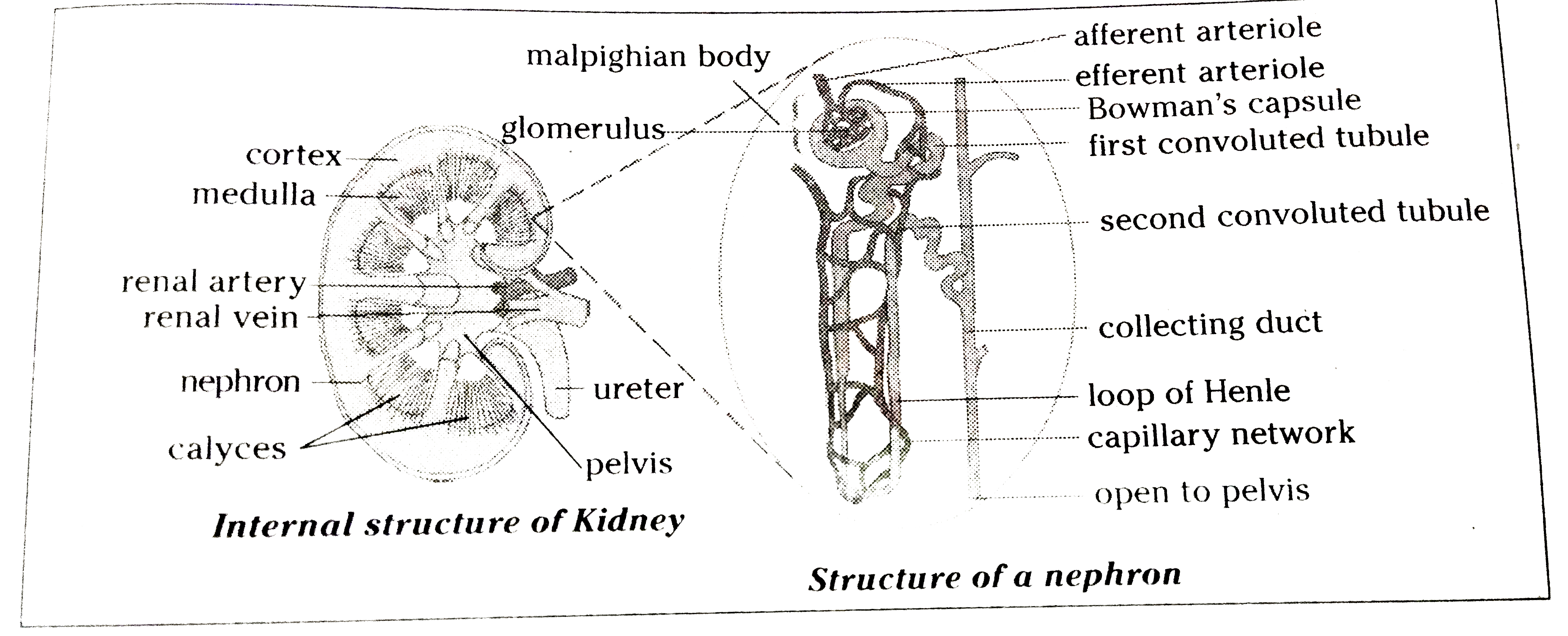 4) Malpighian body consists of a BLIND cup shaped broader end of nephron called Bowman's capsule and bunch of fine blood capillaries called glomerulus. 5) Glomerulus develops from AFFERENT arteriole and it gives to rise to an efferent arteriole. 6) Glomerulus functions as a filtration unit. 7) Renal tubule has three parts: They are I) Proximal convoluted tubule (PCT) 2) Loop of Henle which is 'U' shaped and 3) Distal convoluted tubule (DCT) . 8) In tubule part reabsorption and SECRETION takes place. Urine is formed in the renal tubule part of nephron. 9) Distal convoluted tubules OPEN into a collecting tube. 10) Collecting tube forms pyramids and calyces which open into the pelvis. 11) Pelvis leads into the ureter. |
|
| 3730. |
Question : Describe the glands involved in the digestive system. |
Answer» SOLUTION :
|
|
| 3731. |
Question : List out the things that makes you amazing in excretory system of human being. |
|
Answer» Solution :1) The excretory SYSTEM of man consists of a) a pair of kidneys b) ureters and c) urinary bladder and d) urethra. 2) Kidneys are bean shaped and are LOCATED in the abdominal region on either side of vertebral column. 3) From hilus of eaah kidney there are a pair of whitish, narrow tubular structures arise. They are KNOWN as ureters. 4) The ureter travels DOWNWARDS and open, in the sac like structure called the urinary bladder, which stores urine 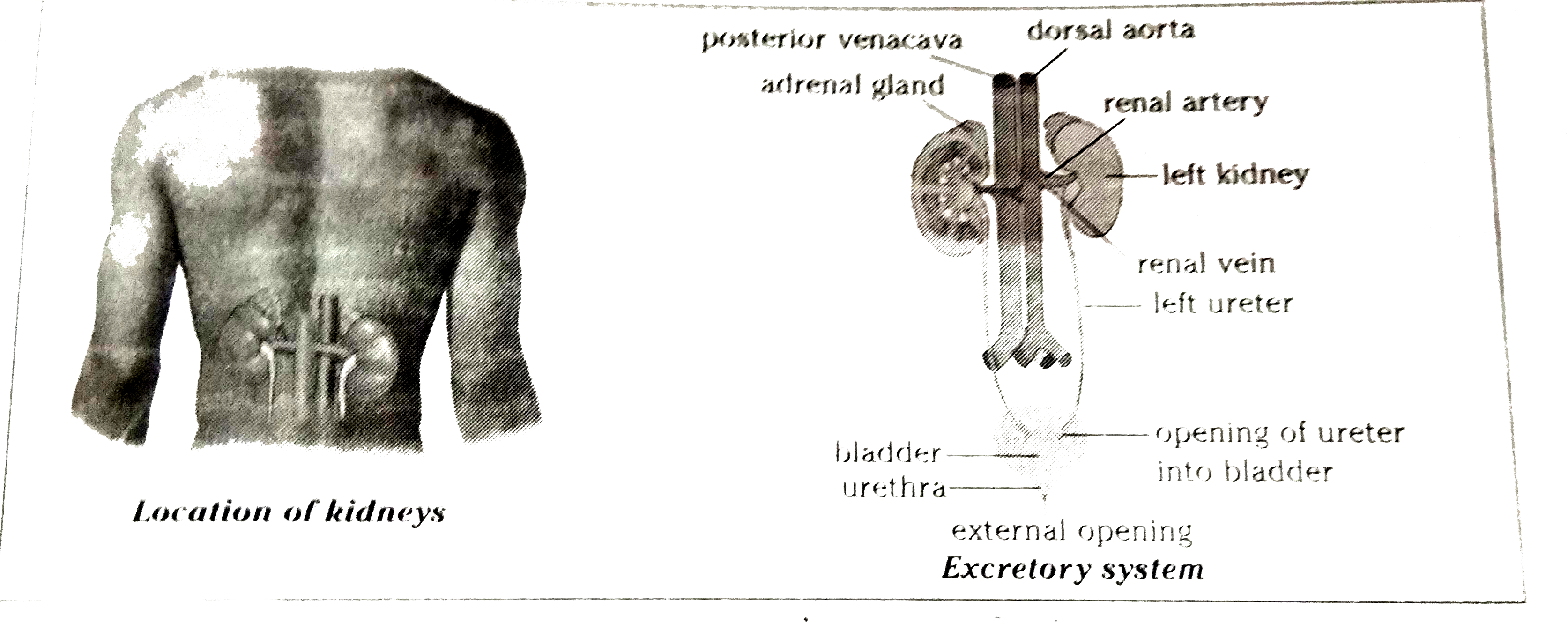 5) Urethra is a tube that takes urine from urinary bladder to outside. 6) The OPENING of urinary bladder into urethra is guarded by a ring of muscles or sphmcter. |
|
| 3732. |
Question : Describe the digestion of food in stomach. |
Answer» Solution :Mammalian (human) alimentary canal comprises mouth , buccal cavity , pharynx , oesophagus stomach , small intestine (duodenum , jejunum and ileum) , large intestine ( caecum , colon and rectum ) and anus.  Buccal cavity. The mouth is a slit-like APERTURE bounded by two lips. It leads to buccal cavity. Its roof is formed of hard palate, continues as soft palate, and hangs as uvula. The sides of buccal cavity are formed by cheeks. At the floor is PRESENT a musculo-sensory organ called tongue. Teeth are present for mastication of food. Pharynx. It is a vertical tube. It is a cross passage for food and air. It has uvula and epiglottis which closes the internal nares and glottis respectively during swallowing of food to ensure the passage of food into oesophagus (food pipe). Oesophagus. It is a 25 cm long narrow muscular straight tube. It runs downward through the chest behind heart and passes through the diaphragm into the abdomen. Here, it OPENS into stomach. Oesophagus propels the swallowed food into stomach. Stomach. It is a sac-like structure situated in the upper part of abdominal cavity below the diaphragm. Large part of this sac is situated left of the median line. Small Intestine. It is the longest part of alimentary canal. It is thin-walled and highly coiled tubular structure. It is about 3-3.5 METRES long and occupies most part of abdominal cavity. It is coiled upon itself. It is differentiated into three regions, viz., duodenum, jejunum and ileum. Its inner lining is thrown into numerous villi. Large intestine. The large intestine is about 1.5 metres long. It is DIVIDED into following parts, i.e. the vermiform appendix, the colon and the rectum. Caecum is a blind tube and represented by vermiform appendix (5-8 cms) and is present below the junction of small and large intestine. Rectum is the last part and opens to the outside by anus guarded by anal sphincter. |
|
| 3733. |
Question : Describe the developmental stages of human embryo after fertilization with the help of neatly labelled diagrams. |
|
Answer» Solution :(1) During fertilization, chromosomes of the ovum and the chromosomes of the sperm make up into pairs and the resulting CELL is called zygote. (2) Fertilization takes place in the oviduct or fallopian tube. (3) The zygote which is diploid travels down the fallopian tube . As it moves it undergoes SEVERAL mitotic divisions formating the embryonic STAGE called blastocyst. (4) Blastocyst moves towards the wall of the uterus and finally GETS attched and embedded in the wall of the uterus . This is called implantation. (5) The growing embryo forms two membrances chorion and Amnion.  (6) Chorion establishes CONNECTION with the walls of the uterus and helps in the supply of nutrients to the embryo and removal of wastes from the embryo. (7) Amnion froms a sec like structure around the embryo . The space between the amnion and embryo is filled with a fluid called amniotic fluit . (8) Amnion and amniotic fluid give orotection to the embryo against minor mechanical injury. (9) Placenta is a tissue formed by the cells from the embryo and the mother. It is formed around 12 week of pregnancy.  (10) Plancenta nourishes the growing embryo. (11) A tough cord called umbilical cord also formed by the embryo which is connected to the walls of the uterus through the placenta. (12)From 3 months of pregnancy , the embryo is called foetus. (13) Pregnancy lasts on an average 9 month or 280 days . This period is called gestation period . |
|
| 3734. |
Question : Describe the contribution of Lamarck. |
| Answer» SOLUTION :The gradual unfolding of ORGANISMS from pre-existing organisms through changes since the beginning of life is called evolution. The theory proposed by J.B. Lamarck is KNOWN as the theory of inheritance of acquired characters. According to this theory, the USE and disuse of an organ leads to ACQUIRING of change in that organ. These changes or variations can be passed on from one generation to the next but this idea of inheritance of acquired characters was soon discarded. | |
| 3735. |
Question : Describe the alimentary cancel of man. |
|
Answer» Solution :Alimentary cancel of manIt measures about 8 to 10 metres in length and extends from mouth to anus. It has following parts Mouth It consists of the oral cavity, through which food is ingested . It contains TEETH , tongue and three pairs of salivary glands. PharynxThe oral cavity opens into the pharynx . The swallowing guides the masticated food through the pharynx into a tube , called oesophagus. OesophagusIt is a MUSCULAR , tubular part of the alimentary canal . The muscular movement called peristalsis carries the food down to the STOMACH. StomachIt is a J-shaped sac - like muscular structure that serves as a storehouse offood . It is a large organ which exoands when food enters it. The muscular walls helps in mixing food thoroughly with more digestive juices. Small intestone It is about 6 metres in length and has three divisions , i.e., duodenum (first part as C - shaped, begins from the pyloric stomach), jejunum and ileum. Large intestineThe ileum passes into large intestine , which can be divided into two parts as anterior colon and posterior rectum. The terminal part of rectum is called anal canal . It opens through the anus, guarded byaphincter MUSCLES. It allows the feacal matter to be egested out. 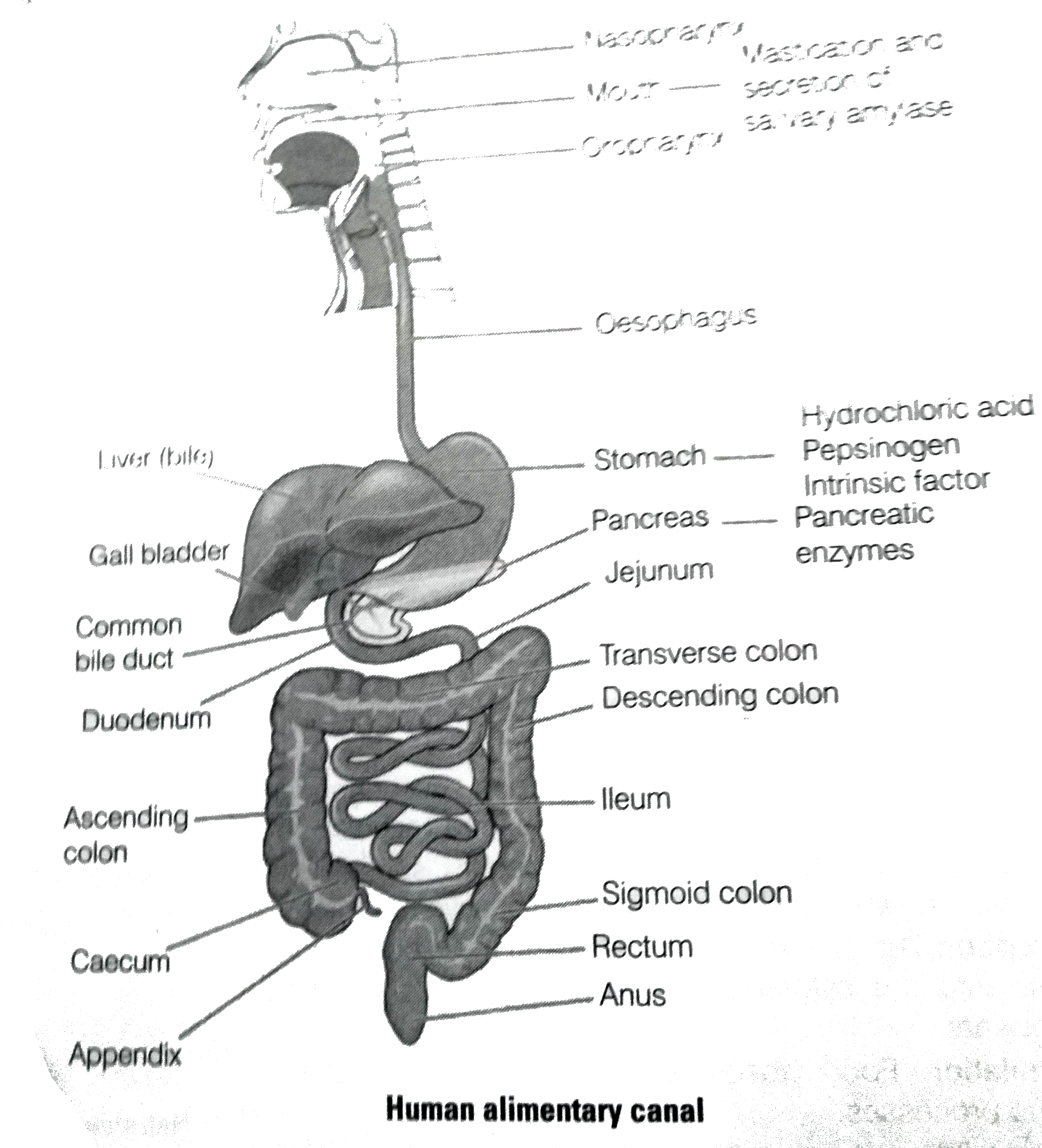
|
|
| 3736. |
Question : Describe sex determination in the human beings. |
|
Answer» Solution :The sex determination in HUMAN beings is due to chromosomes and thus it is genetically determined. Human beings have 23 pairs of chromosomes. Each pair has one maternal and one paternal copy. `rarr` 22 pairs of chromosomes are similar in both male and FEMALE. They are called autosomes, as they decide body characters. `rarr` 23rd pair has sex chromosomes. `rarr` Women have a pair of X chromosomes, i.e., females are THEREFORE XX. `rarr` Men have a mismatched pair in which one is normal sized X while the other is a short one called Y, i.e., Males are therefore XY.  As shown in FIGURE, the probability of getting a male (boy) or a female (girl) child is `50%`. All children will inherit an X-chromosome from their mother regardless of whether they are boys or girls. Thus, the sex of the children will be determined by what they inherit from their father. A child who inherits an X-chromosome from father will be girl and one who inherits a Y-chromosome from father will be a boy. |
|
| 3737. |
Question : Describe regeneration in Planaria. |
|
Answer» Solution :Regeneration in Planaria. When the anterior end of Planaria is cut along the length into two more parts, each part develops into a new head, resulting in a many headed planaria. 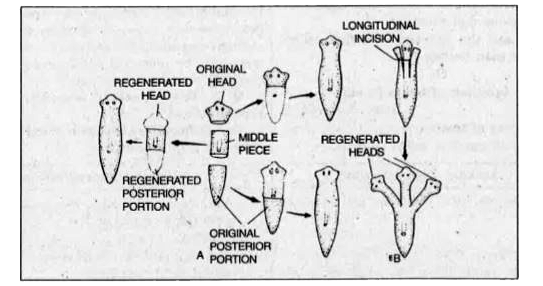 If the BODY is cut into three, four or more pieces, each piece regenerate the missing parts. A noteworthy observation in this CASE is that a piece from the middle always regenerates a head towards its anterior side and tail towards its POSTERIOR side. In other words, each piece maintains its original polarity. A possible explanation of this fact is that in Planaria, the metabolic ACTIVITY and hence capacity for regeneration, is the greatest at the anterior end, GRADUALLY decreases posteriorly and is minimum at the posterior end. Correspondingly, the anterior end of each piece, having greater metabolic activity, regenerates anterior part of the body and the posterior end remain as such. |
|
| 3738. |
Question : Describe mutation breeding with an example. |
|
Answer» Solution :Mutation is defined as the sudden HERITABLE CHANGE in the nucleotide sequence of DNA in an organism. The genetic variations, brings out changes in an organism. The organism which undergoes mutation is called a mutant. The factors which induce mutations are known as mutagens or mutagenic agents. The mutagens are of TWO types: (a) Physical mutagens: Radiations like X-ray`alpha`,beta and gamma`-rays, UV rays and temperature, etc, which induce, maturations are called physical mutagens (b) Chemical mutagens: Chemical SUBSTANCES that induce mutations are called chemical mutagens. eg. Mustard gas and nitrous acid. The utilization of induced mutation in crop improvement is called mutation inbreeding Achievements of mutation breeding: (a) SHARBATI Sonora wheat produced from Sonora. 64 by using gamma rays. (b) Atomita-2 rice with saline tolerance and pest resistance (c) Groundnuts with thick shells. |
|
| 3739. |
Question : Describe menstrual cycle. |
| Answer» Solution :After attaining puberty, human female produces one egg during middle of each menstrual cycle. This process is TERMED as ovulation. As the follicle matures to release the egg, the uterine wall thickens, in PREPARATION for receiving fertilised egg. In case fertilisation does not occur, the thickened INNER wall of UTERUS breaks down alongwith the blood vessels and comes out through vagina in the form of menstrual flow. This process takes approximately 28 - 30 DAYS and is known as menstrual cycle. | |
| 3740. |
Question : Describe internal structure of a human heart. |
Answer» Solution :The two auricles or atria are thin-walled and are separated from each other by a thin inter-atrial septum. The right atrium receives VENOUS (deoxygenated blood having very little `O_(2)` ) from the entire body through a superior and inferior vena cava. The left smaller atrium receives oxygenated blood from the lungs through four pulmonary veins.The two auricles (atria) are separated from the ventricles by two apertures guarded by membranous valves. The valve separating right atrium from right ventricle is called right atrio-ventricular valve or tricuspid valve made up of three flaps. The valve separating left atrium from left ventricle is called left atrio-ventricular valve or mitral valve, formed of two flaps. These valves are attached with fine cords with the papillary MUSCLES of the ventricular wall. These valves only allow blood flow from auricles into ventricles and not in opposite direction. 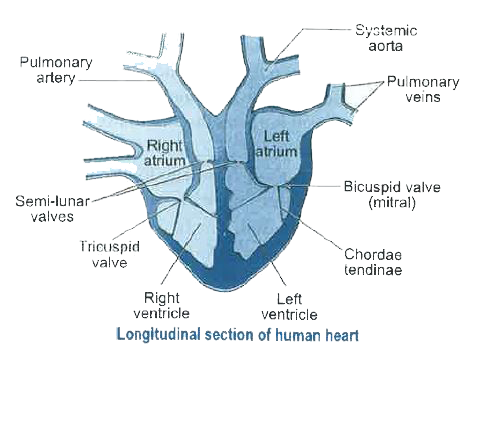 Both the ventricles are separated from each other by a thick inter-ventricular septum, rhe wall of left ventricle is MUCH thicker than that of right ventricle. The left ventricle pushes blood into aorta which supplies blood to entire body. The opening of aorta is also guarded by a valve formed of 3 semilunar flaps. The right ventricle pumps venous blood into lungs by a pulmonary aorta. Its opening is also guarded by a valve, having 3 semilunar flaps. These valves allow the flow of blood from ventricles into the aorta and not back. Heart is formed of cardiac muscle FIBRES, which rhythmically contract the heart WITHOUT feeling fatigue. |
|
| 3741. |
Question : Describe in brief the function of various parts of female reproductive part of bisexual flower. |
|
Answer» Solution :(i) Sepals and petals : Sepals in the calyx cup protect the flower in the bud stage. They persist in the fruit. Petals of insect pollinated flowers are brightly COLORED and scented to attract bees and butterflies for pollination, They are colourless and inconspicuous in wind pollinated flowers. (ii) Stamen : This is the male reproductive part of the flower. The anther produces pollen grains. (iii) Carpel : It has a swollen bottom part called ovary, a middle elongated part called style and a sticky terminal part called stigma. The ovary contains ovules which CONTAIN the female GAMETES – the EGGS. |
|
| 3742. |
Question : Describe human alimentary canal . Draw a labelled diagram of human alimentary canal. |
Answer» Solution :Mammalian (human) alimentary canal comprises mouth , buccal cavity , pharynx , oesophagus stomach , small INTESTINE (duodenum , jejunum and ILEUM) , large intestine ( caecum , colon and rectum ) and anus.  Buccal cavity. The mouth is a slit-like aperture bounded by two lips. It leads to buccal cavity. Its roof is formed of hard palate, continues as soft palate, and hangs as uvula. The sides of buccal cavity are formed by cheeks. At the floor is PRESENT a musculo-sensory organ called tongue. Teeth are present for mastication of food. Pharynx. It is a vertical tube. It is a cross passage for food and air. It has uvula and epiglottis which closes the internal nares and glottis respectively during swallowing of food to ensure the passage of food into oesophagus (food pipe). Oesophagus. It is a 25 cm long narrow muscular straight tube. It runs downward through the chest behind heart and passes through the diaphragm into the abdomen. Here, it opens into stomach. Oesophagus propels the swallowed food into stomach. Stomach. It is a sac-like structure situated in the upper part of abdominal cavity below the diaphragm. Large part of this sac is situated left of the median line. Small Intestine. It is the longest part of alimentary canal. It is thin-walled and highly coiled tubular structure. It is about 3-3.5 metres long and occupies most part of abdominal cavity. It is coiled upon itself. It is differentiated into three REGIONS, viz., duodenum, jejunum and ileum. Its inner lining is THROWN into numerous villi. Large intestine. The large intestine is about 1.5 metres long. It is divided into following parts, i.e. the vermiform appendix, the colon and the rectum. Caecum is a blind tube and represented by vermiform appendix (5-8 cms) and is present below the junction of small and large intestine. Rectum is the last part and opens to the outside by anus guarded by anal sphincter. |
|
| 3743. |
Question : Describe how oxygen enters the blood in lungs with the help of a block diagram. |
|
Answer» Solution :(1)Gaseous exchange takes place WITHIN the lungs by diffusion from the alveoli to blood capillaries and vice versa. Alveoli in lungs are numerous and only one cell thick. (2)Alveoli are surrounded by capillaries that are also one cell thick. (3)Blood, dark red in COLOUR flows from the heart through these capillaries and collects OXYGEN from the alveoli. (4)At the same time, carbon dioxide passes out of the capillaries and into the alveoli. (5)When we BREATHE out , we get rid of carbon dioxide . (6) The bright red, oxygen rich blood is returned to the heart and pumped out to all parts of the body. 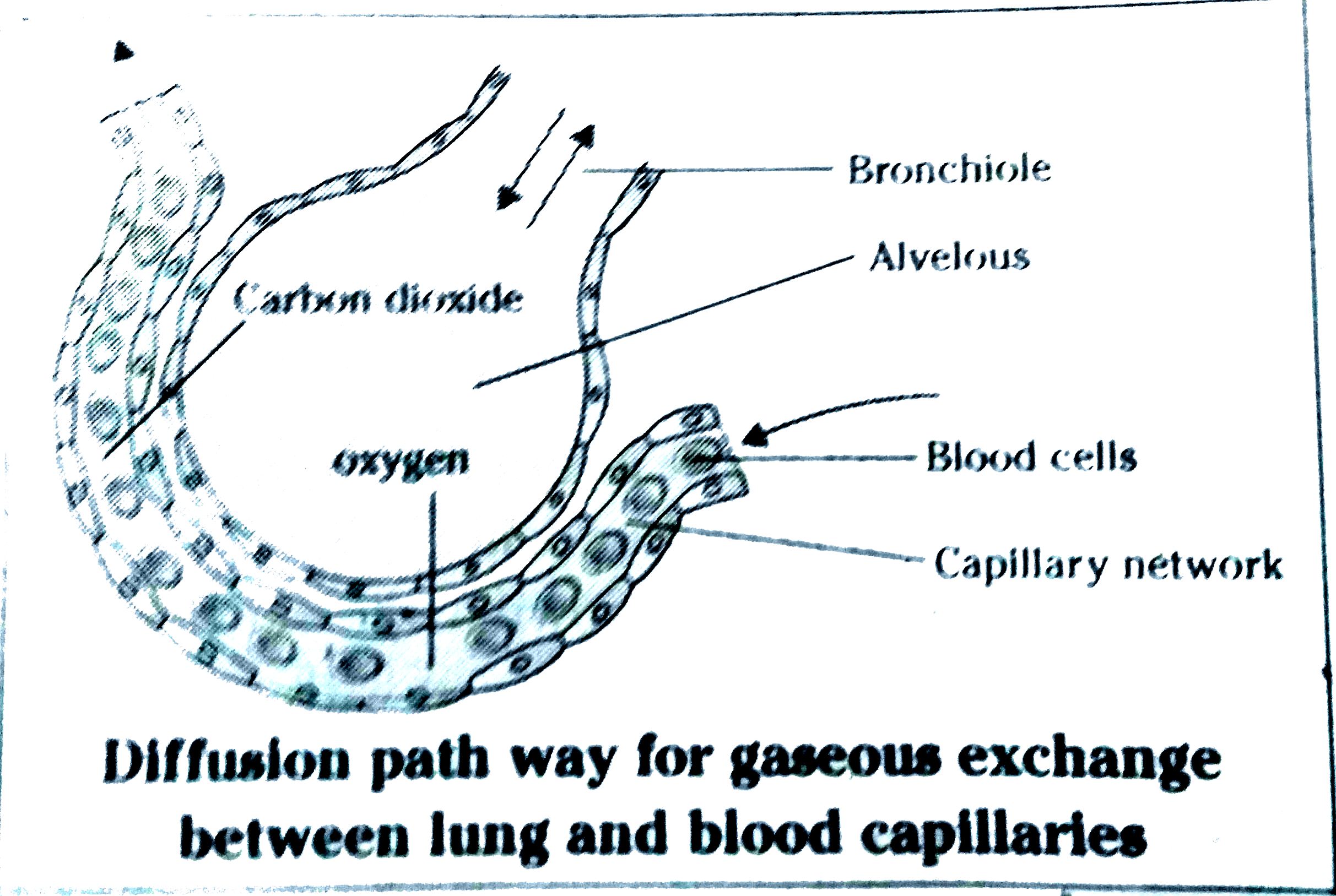
|
|
| 3744. |
Question : Describe excretion in plants. |
|
Answer» SOLUTION : The waste materials which must be removed are solid, liquid and gaseous substances. Plants excrete these in manner which is different than that found in animals. Plants get RID of gaseus substances through stomata. The common gaseous wastes are oxygen and `CO_(2)`. Oxygen is produced due to PHOTOSYNTHESIS and `CO_(2)` is produced due to respiration. The excess water taken through roots is also removed through stomata. Some of it is also removed through general body surface. The process of removal of water is called transpiration. The solids are deposited in the leaves. The portions of leaves having waste deposited in them lose their green colour and become dead. FINALLY the dead leaves are shed to get RED of the waste. |
|
| 3745. |
Question : Describe double fertilisation in plants. |
|
Answer» Solution : SOON after pollination the pollen GRAINS start germinating and form a pollen tube. The pollen tube grows WITHIN the style till it reaches the ovary. On reaching the ovary it enters the ovule through an opening called micropyle. In the meantime, two male gametes are formed in the pollen tube. One of the male gametes fuses with the egg, the process is called syngamy. The product formed is termed as zygote. The other male GAMETE fuses with the two polar nuclei, one from each end of embryo SAC, to form endosperm nucleus. This process is called triple fusion. In this process three nuclei, two polar nuclei and one male gamete is involved, so it is called triple fusion. Thus, inside each embryo sac two fusions, i.e., syngamy and triple fusion take place. This mechanism of two fusions occurring in an embryonal sac is called double fertilisation. After fertilisation, the ovule develops into seed and the ovary develops into a fruit. |
|
| 3746. |
Question :Describe double circulation in human beings. Why is it necessary? |
Answer» Solution :The blood passes through the heart twice through separate pathways for completing one cycle. This type of circulation is called double circulation. 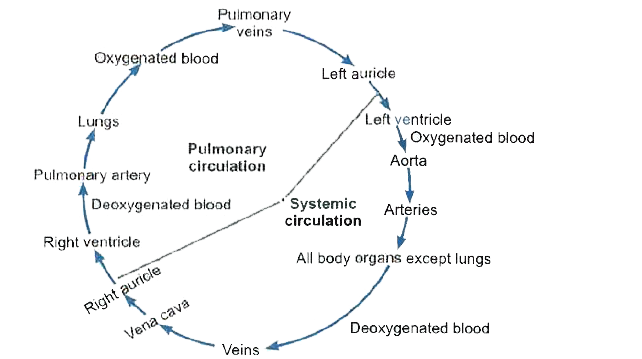 The double circulation of blood includes: (i) Systemic circulation (ii) Pulmonary circulations. (i) Systemic circulation: It supplies oxygenated blood from left auricle to left ventricle, which is pum ped to aorta to distribute blood to various body parts. The deoxygenated blood is collected from the various body organs by the veins to pour into vena cava and finally into the right atrium (auricle). Right atrium transfers this blood into the right ventricle. (ii) Pulmonary circulation: The deoxygenated blood is PUSHED by the right ventricle into the lungs for oxygenation through pulmonary artery. The oxygenated blood is brought back to left atrium of the human heart through pulmonary vein. From left atrium, the oxygenated blood is pushed into the left ventricle. The left ventricle pumps oxygenated blood into aorta for systemic circulation. NECESSITY of double circulation: In humans, having four-chambered heart (which consists of two auricle and two ventricle) the left side and right side of heart are completely separated to prevent the oxygenated blood from mixing with deoxygenated blood. Such a separation allows a highly efficient supply of oxygen to the body cells which is necessary for producing a LOT of energy. This energy is useful in CASE of human beings that have high energy need because they CONSTANTLY require energy to maintain their body temperature. |
|
| 3747. |
Question : Describe double circulation in human beings, Why is it necessary ? |
| Answer» SOLUTION :The human heart CONSISTS of two sides : right and left. The right side of the heart receives deoxygenated blood and sends it further for purification to lungs. The left side of heart receives oxygenated blood from the lungs which is pumped further and sent to all the parts of the BODY through blood VESSELS. This is called doubled circulation. The energy demands for human beings is too large and hence it is necessary for the separation of oxygenated and deoxygenated blood to meet this energy demand. | |
| 3748. |
Question : Describe double circulation in human beings. Whyis it necessary ? |
|
Answer» Solution :Double CIRCULATION is thepassage of the same blook twice through the heart, first on the rightside then on THELEFT side in orderto complete one cycle. Double circulation has two components : Pulmonary circulation and systemic circulation . Pulmonary circulation - It is the movementof blood from heart to thelungs andback. De-oxygenatedblood of the body enters the rightartricle, passes into rights ventricle which pumpsit into pulmonary ARCH. Withthe help of twoseparate pulmonary arteriesthe blood passes into the lungs. Herethe arteries breakup into arterioles and then capillaries for oxygenation. Capllaries join to form ventricles and then veins. Oxygenated blook comes back to the left atrium of heart through pulmonary veins. Systemic circulation - It isthe circulation of bloodbetween heart and different PARTS of thebody except lungs. Oxygenatedbloodreceived by left atrium passesinto left ventricle. The left ventricle pumpsit intoaorta forsupply to different body parts. Inside the organs the arteriesbreak up into arterioles and then capillaries.Capillaries provide oxygen and nutrientsto tissues.Theyreceive carbon dioxide andwastes from the tissuces.receive carbon dioxide and wastes from the tissues.Capillaries UNITE to form venules which join to produceveins. Veinstakethe de-oxygenated blood to theheart but nowinto the rightatricle . Significance of double circulation - Itensures quick and efficientsupply of oxygenated blook to all body parts for meetinghigherenergy needs and forthermoregulation of body in mammalsand birds. 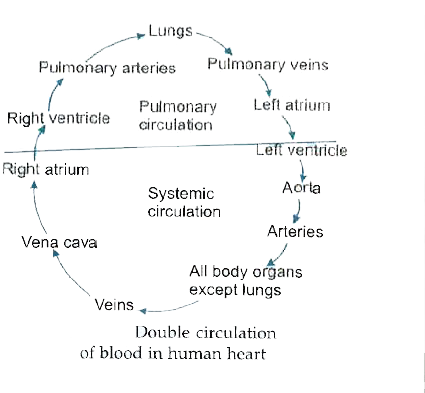
|
|
| 3749. |
Question : Describe Darwin's theory of evolution. |
|
Answer» SOLUTION :Following are the points of Darwin.s theory of natural selection: (i) Over-production: EVERY organism has enormous potential to reproduce. (ii) Struggle for existence: Population size of an organism is limited due to struggle between the members of same SPECIES as well as the members of different species. It is due to struggle for food, space and mate. (iii) Variation: Due to struggle, the fit organisms possess some VARIATIONS which are favourable, and they can leave the progeny to continue the favourable variations. (iv) Survival of the fittest: The fittest organism survive to continue the favourable variations. (v) Formation of a new species: These variations when accumulated for a long time, leads to the origin of a new species. |
|
| 3750. |
Question :Describe briefly four ways in which individuals with aparticular trait may increase in a population? |
| Answer» SOLUTION :The FOUR ways in which individuals with a particular trait may INCREASE in a population are as follows:. Sexual reproduction results into variation.The individuals with special traits survive the attack of their predotors and multiply while the other will perish . Genetic drift provides without any adaptation.Variation in the species may lead to INCREASED urvival of the be individuals. | |